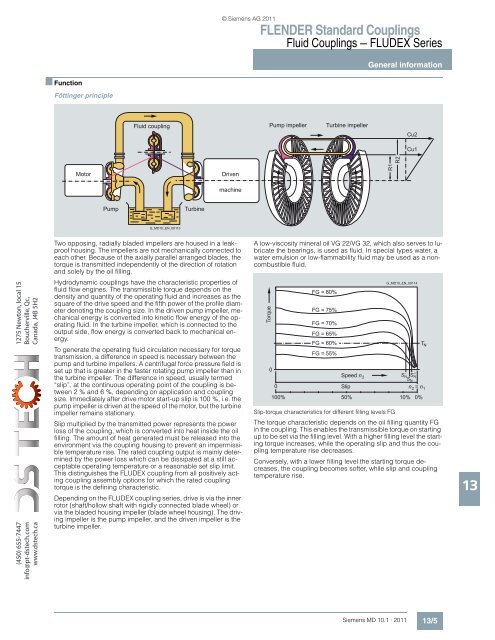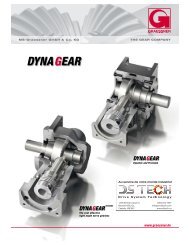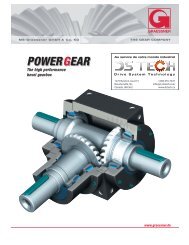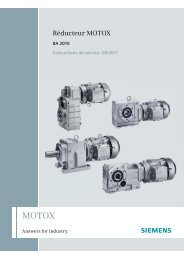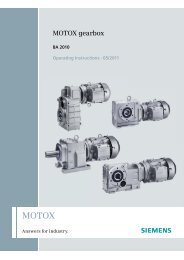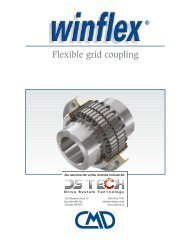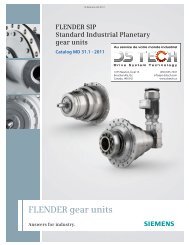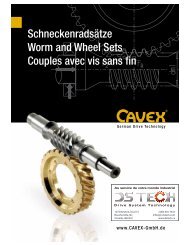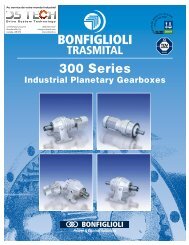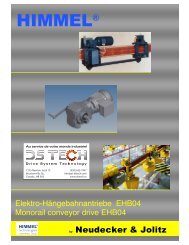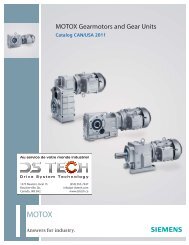FLENDER Standard Couplings - DS TECH
FLENDER Standard Couplings - DS TECH
FLENDER Standard Couplings - DS TECH
- No tags were found...
You also want an ePaper? Increase the reach of your titles
YUMPU automatically turns print PDFs into web optimized ePapers that Google loves.
© Siemens AG 2011<br />
<strong>FLENDER</strong> <strong>Standard</strong> <strong>Couplings</strong><br />
Fluid <strong>Couplings</strong> — FLUDEX Series<br />
General information<br />
■ Function<br />
Föttinger principle<br />
Fluid coupling<br />
Pump impeller<br />
Turbine impeller<br />
Cu2<br />
Cu1<br />
Motor<br />
Driven<br />
R1<br />
R2<br />
machine<br />
Pump<br />
Turbine<br />
G_MD10_EN_00113<br />
Two opposing, radially bladed impellers are housed in a leakproof<br />
housing. The impellers are not mechanically connected to<br />
each other. Because of the axially parallel arranged blades, the<br />
torque is transmitted independently of the direction of rotation<br />
and solely by the oil filling.<br />
A low-viscosity mineral oil VG 22/VG 32, which also serves to lubricate<br />
the bearings, is used as fluid. In special types water, a<br />
water emulsion or low-flammability fluid may be used as a noncombustible<br />
fluid.<br />
1275 Newton, local 15<br />
Boucherville, Qc,<br />
Canada, J4B 5H2<br />
(450) 655-7447<br />
info@pt-dstech.com<br />
www.dstech.ca<br />
Hydrodynamic couplings have the characteristic properties of<br />
fluid flow engines. The transmissible torque depends on the<br />
density and quantity of the operating fluid and increases as the<br />
square of the drive speed and the fifth power of the profile diameter<br />
denoting the coupling size. In the driven pump impeller, mechanical<br />
energy is converted into kinetic flow energy of the operating<br />
fluid. In the turbine impeller, which is connected to the<br />
output side, flow energy is converted back to mechanical energy.<br />
To generate the operating fluid circulation necessary for torque<br />
transmission, a difference in speed is necessary between the<br />
pump and turbine impellers. A centrifugal force pressure field is<br />
set up that is greater in the faster rotating pump impeller than in<br />
the turbine impeller. The difference in speed, usually termed<br />
“slip”, at the continuous operating point of the coupling is between<br />
2 % and 6 %, depending on application and coupling<br />
size. Immediately after drive motor start-up slip is 100 %, i.e. the<br />
pump impeller is driven at the speed of the motor, but the turbine<br />
impeller remains stationary.<br />
Slip multiplied by the transmitted power represents the power<br />
loss of the coupling, which is converted into heat inside the oil<br />
filling. The amount of heat generated must be released into the<br />
environment via the coupling housing to prevent an impermissible<br />
temperature rise. The rated coupling output is mainly determined<br />
by the power loss which can be dissipated at a still acceptable<br />
operating temperature or a reasonable set slip limit.<br />
This distinguishes the FLUDEX coupling from all positively acting<br />
coupling assembly options for which the rated coupling<br />
torque is the defining characteristic.<br />
Depending on the FLUDEX coupling series, drive is via the inner<br />
rotor (shaft/hollow shaft with rigidly connected blade wheel) or<br />
via the bladed housing impeller (blade wheel housing). The driving<br />
impeller is the pump impeller, and the driven impeller is the<br />
turbine impeller.<br />
Torque<br />
0<br />
0<br />
100%<br />
FG = 80%<br />
FG = 75%<br />
FG = 70%<br />
FG = 65%<br />
FG = 60%<br />
FG = 55%<br />
Speed n2<br />
Slip<br />
50% 10% 0%<br />
Slip-torque characteristics for different filling levels FG<br />
G_MD10_EN_00114<br />
SN<br />
S N<br />
S N<br />
n2<br />
= n 1<br />
The torque characteristic depends on the oil filling quantity FG<br />
in the coupling. This enables the transmissible torque on starting<br />
up to be set via the filling level. With a higher filling level the starting<br />
torque increases, while the operating slip and thus the coupling<br />
temperature rise decreases.<br />
Conversely, with a lower filling level the starting torque decreases,<br />
the coupling becomes softer, while slip and coupling<br />
temperature rise.<br />
T N<br />
13<br />
Siemens MD 10.1 · 2011<br />
13/5


